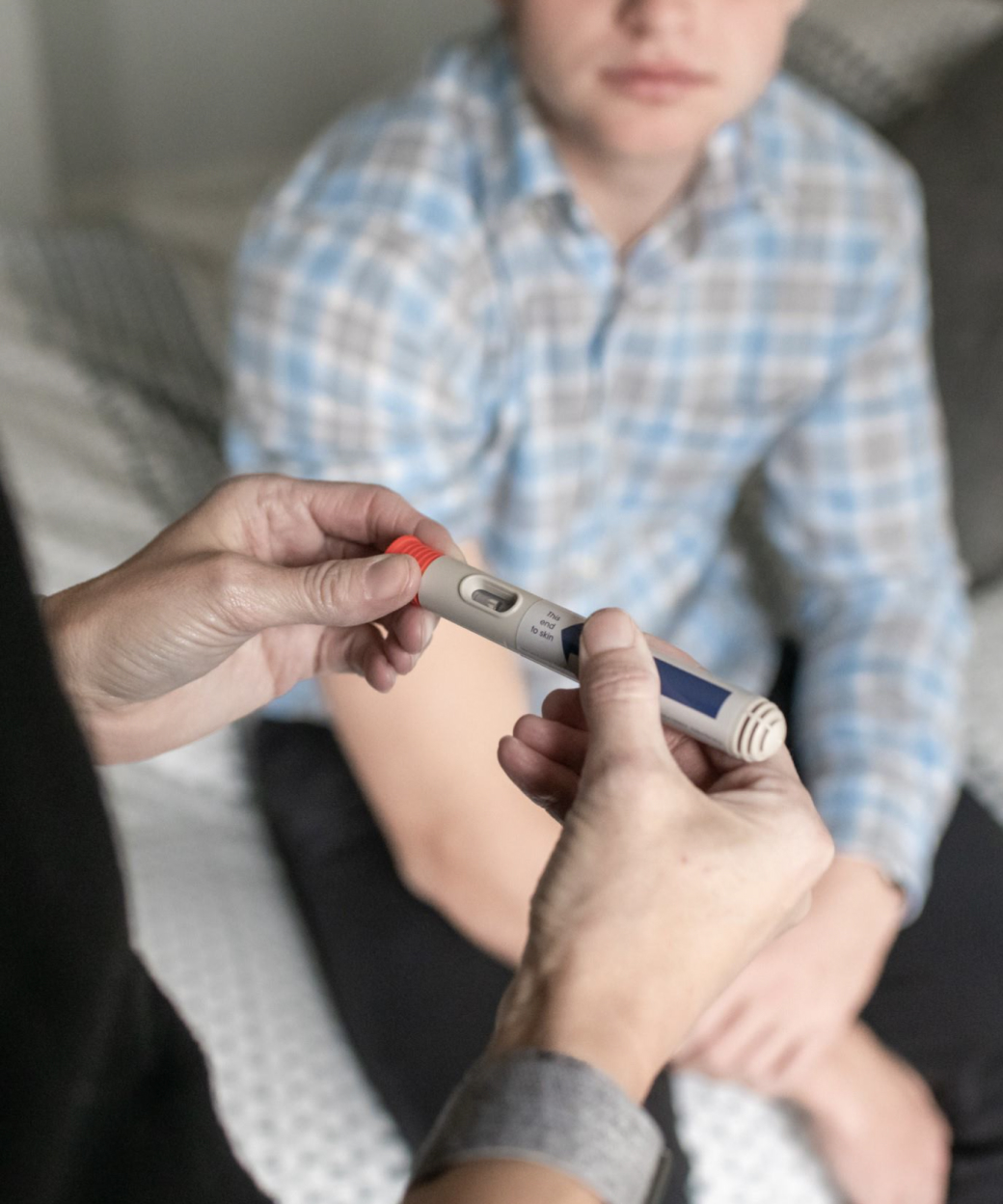Face Very Low Blood Sugar With Confidence

What Is Severe Low Blood Sugar?
A severe low blood sugar event is a potentially life-threatening emergency that requires immediate attention1
If low blood sugar is left untreated, it can progress to severe low blood sugar.
Severe low blood sugar occurs when your blood sugar — the main source of fuel for the body and brain — gets too low for bodily functions to operate properly and requires help to recover.
Severe low blood sugar can be unpredictable. That’s why it’s important to:
- Know the signs and symptoms
- Have a treatment plan that includes ready-to-use glucagon so that you and those around you can treat very low blood sugar with confidence.
Who’s at risk?
Whether you have type 1 or type 2 diabetes, you could be at increased risk for low blood sugar (hypoglycemia).
The American Diabetes Association (ADA) has established factors that can increase your risk of developing hypoglycemia2:
- You take medications known to cause low blood sugar like insulin or sulfonylureas
- Longer duration of diabetes
- Older age
- Cognitive impairment (problems with memory or thinking)
- Consuming alcohol
- Hypoglycemia unawareness (do not feel symptoms of low blood sugar)
- Irregular mealtimes
- Use of many different types of medications
- History of a severe low blood sugar event
How To Treat a Severe Low Blood Sugar Event
Work with your healthcare provider to create a plan for managing low blood sugar
Low blood sugar (hypoglycemia) requires immediate attention. For mild hypoglycemia (blood sugar below 70 mg/dL) or moderate hypoglycemia (blood sugar below 54 mg/dL), it is recommended to treat promptly with 15 grams of oral fast-acting carbohydrates (e.g., glucose tablets or juice).3 Then, retest in 15 minutes and repeat the process until your target blood sugar level is reached.
But there may be times when you need glucagon to treat a severe low. Because glucagon can rapidly reverse severe hypoglycemia, it’s viewed as one of the primary treatments for very low blood sugar.1,4 It can be used if you5:
- Have tried correcting with food or drink and it’s not working
- Are unable to swallow safely
- Feel like passing out
- Pass out or have a seizure
Ready-To-Use Glucagon Can Make All the Difference
You need a safety net that can be used the moment it’s needed during a low blood sugar emergency. That’s why the glucagon formulation you decide on with your healthcare provider matters.
If you take insulin or certain diabetes pills known to cause low blood sugar and don’t have ready-to-use glucagon in your treatment plan, talk to your healthcare provider right away.
Here’s why:
1. Guidelines recommend it.1,3
2. Sometimes things don’t go according to plan.
3. Simple administration matters.
Gvoke HypoPen® Is the Ready-to-Use Rescue Pen You Need in Your Toolkit
You’ve likely heard about rescue pens for severe allergic reactions. Did you know the same type of tool is available for low blood sugar emergencies?
Gvoke HypoPen is a ready-to-use glucagon rescue pen for very low blood sugar. It is 2 simple steps to administer5— in fact, it was used correctly by 99% of people in a study designed to simulate an emergency,6 and you can even self-administer it in certain cases.
*Demonstration device shown.

REFERENCES:
-
- McCall AL, Lieb DC, Gianchandani R, et al. Management of individuals with diabetes at high risk for hypoglycemia: an Endocrine Society clinical practice guideline. J Clin Endocrinol Metab. 2023;108(3):529-562.doi:10.1210/clinem/dgac596
- ElSayed NA, Aleppo G, Aroda VR, et al. 4. Comprehensive Medical Evaluation and Assessment of Comorbidities: Standards of Care in Diabetes-2023 [published correction appears in Diabetes Care. 2023 Jun 25;:]. Diabetes Care. 2023;46(Suppl 1):S49-S67. doi:10.2337/dc23-S004
- ElSayed NA, Aleppo G, Aroda VR, et al. 6. Glycemic Targets: Standards of Care in Diabetes-2023. Diabetes Care. 2023;46(Suppl 1):S97-S110. doi:10.2337/dc23-S006
- Treatment of low blood sugar (hypoglycemia). Center for Disease Control and Prevention. Updated May 15, 2024. Accessed June 21, 2024. https://www.cdc.gov/diabetes/treatment/treatment-low-blood-sugar-hypoglycemia.html
- Gvoke HypoPen [instructions for use]. Chicago, IL: Xeris Pharmaceuticals, Inc.
- Valentine V, Newswanger B, Prestrelski S, Andre AD, Garibaldi M. Human Factors Usability and Validation Studies of a Glucagon Autoinjector in a Simulated Severe Hypoglycemia Rescue Situation. Diabetes Technol Ther. 2019;21(9):522-530. doi:10.1089/dia.2019.0148
INDICATION AND SAFETY SUMMARY
GVOKE is a prescription medicine used to treat very low blood sugar (severe hypoglycemia) in adults and kids with diabetes ages 2 years and above. It is not known if GVOKE is safe and effective in children under 2 years of age.
WARNINGS
Do not use GVOKE if:
- you have a tumor in the gland on top of your kidneys (adrenal gland), called a pheochromocytoma.
- you have a tumor in your pancreas called an insulinoma.
- you are allergic to glucagon or any inactive ingredient in GVOKE.
GVOKE MAY CAUSE SERIOUS SIDE EFFECTS, INCLUDING:
High blood pressure
GVOKE can cause high blood pressure in certain people with tumors in their adrenal glands.
Low blood sugar
GVOKE can cause low blood sugar in certain people with tumors in their pancreas called insulinomas by making too much insulin in their bodies.
Serious allergic reaction
Call your doctor or get medical help right away if you have a serious allergic reaction including:
- rash
- difficulty breathing
- low blood pressure
COMMON SIDE EFFECTS
The most common side effects of GVOKE in adults include:
- nausea
- vomiting
- swelling at the injection site
- headache
The most common side effects of GVOKE in children include:
- nausea
- low blood sugar
- high blood sugar
- vomiting
- abdominal pain
- headache
- pain or redness at the injection site
- itching
These are not all the possible side effects of GVOKE. For more information, ask your doctor. Call your doctor for medical advice about side effects.
You are encouraged to report side effects of prescription drugs to the FDA. Visit www.fda.gov/medwatch, or call 1-800-FDA-1088.
BEFORE USING
Before using GVOKE, tell your healthcare provider about all your medical conditions, including if you:
- have adrenal gland problems
- have a tumor in your pancreas
- have not had food or water for a long time (prolonged fasting or starvation)
- have low blood sugar that does not go away (chronic hypoglycemia)
- are pregnant or plan to become pregnant
- are breastfeeding or plan to breastfeed. It is not known if GVOKE passes into your breast milk. You and your healthcare provider should decide if you can use GVOKE while breastfeeding.
Tell your healthcare provider about all the medicines you take, including prescription and over-the-counter medicines, vitamins, and herbal supplements.
HOW TO USE
- Read the detailed Instructions for Use that come with GVOKE.
- Use GVOKE exactly how your healthcare provider tells you to use it
- Make sure your relatives, close friends, and caregivers know where you store GVOKE and how to use it the right way before you need their help.
- Act quickly. Having very low blood sugar for a period of time may be harmful.
- Your healthcare provider will tell you how and when to use GVOKE.
- After giving GVOKE, your caregiver should call for emergency medical help right away.
- If you do not respond after 15 minutes, your caregiver may give you another dose, if available. Tell your healthcare provider each time you use GVOKE. Low blood sugar may happen again after receiving an injection of GVOKE. Your diabetes medicine may need to be changed.
HOW TO STORE
- Keep GVOKE pre-filled syringe and HypoPen in sealed foil pouch until time of use.
- Keep GVOKE kit vial and pouched syringe together in original carton until time of use.
- Store GVOKE at temperatures between 68°F and 77°F.
- Do not keep it in the refrigerator or let it freeze.
Keep GVOKE and all medicines out of the reach of children.
For more information, call 1-877-937-4737 or go to www.GvokeGlucagon.com.
Please see the Full Prescribing Information for Gvoke